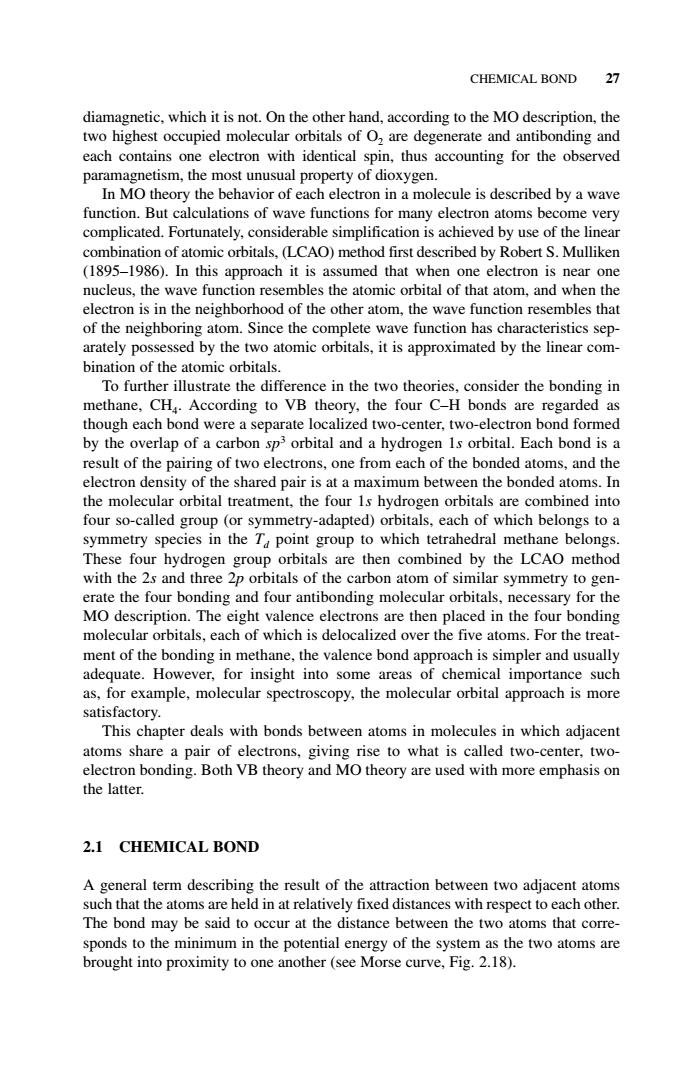正在加载图片...

CHEMICAL BOND 27 diamagnetic.which the other hand,according to the MO deseription.the two highest occupiec molecula orbitals ofare degenerate and antibonding and each contains one electron with identical spin,thus accounting for the observed paramagnetism,the most unusual property of dioxygen. In MO theory the behavior of each electron in a molecule is described by a wave function.But calculations of wave functions for many electron atoms become very complicated.Fortunately,considerable simplification is achieved by use of the linear thod first described by Robert s.Mulliker med that wher one nucleus,t approach it is ve func resemble he tom s in the neighb hood of the other atom,the wave funct on resembles tha of the neighboring atom.Since the complete wave function has characteristics sep arately possessed by the two atomic orbitals,it is approximated by the linear com- bination of the atomic orbitals To further illustrate the difference in the two theories,consider the bonding in methane,CH..According to VB theory,the four C-H bonds are regarded as though each bond were a separate localized two-center.two-electron bond formed by the 、ofa 3 orbital and a byd gen I orbital.Each bond is a result of the pairing I two e electrons. one fr ea of the b s,and th electron density of the shared pair is at a maximum between the bonded atoms.In the molecular orbital treatment,the four 1s hydrogen orbitals are combined into four so-called group (or symmetry-adapted)orbitals,each of which belongs to a symmetry species in the T,point group to which tetrahedral methane belongs These four hydrogen group orbitals are then combined by the LCAO method with the 2s and three 2p orbitals of the carbon atom of similar symmetry to gen ate the four bondir ng and four antibondi molecular orbitals, ssary for MO de The then ced in the fou molecu orbi .each of which i is del over the five atoms.For the trea ment of the bonding in methane,the valence bond approach is simpler and usually adequate.However,for insight into some areas of chemical importance such as,for example,molecular spectroscopy,the molecular orbital approach is more satisfactory. This chapter deals with bonds between atoms in molecules in which adiacent atoms share a nair of electrons,giving rise to what is called two-center,two ron bonding Both VB theory and MO the eory are used with more emphasis or the latte 2.1 CHEMICAL BOND A general term describing the result of the attraction between two adjacent atoms such that the atoms are held in at relatively fixed distances with respect to each other. The bond may be said to occur at the distance between the two atoms that corre eminimum in the tial en rgy of the ronpomity to one another (seMorse cuveg2 the two atoms arediamagnetic, which it is not. On the other hand, according to the MO description, the two highest occupied molecular orbitals of O2 are degenerate and antibonding and each contains one electron with identical spin, thus accounting for the observed paramagnetism, the most unusual property of dioxygen. In MO theory the behavior of each electron in a molecule is described by a wave function. But calculations of wave functions for many electron atoms become very complicated. Fortunately, considerable simplification is achieved by use of the linear combination of atomic orbitals, (LCAO) method first described by Robert S. Mulliken (1895–1986). In this approach it is assumed that when one electron is near one nucleus, the wave function resembles the atomic orbital of that atom, and when the electron is in the neighborhood of the other atom, the wave function resembles that of the neighboring atom. Since the complete wave function has characteristics separately possessed by the two atomic orbitals, it is approximated by the linear combination of the atomic orbitals. To further illustrate the difference in the two theories, consider the bonding in methane, CH4. According to VB theory, the four C–H bonds are regarded as though each bond were a separate localized two-center, two-electron bond formed by the overlap of a carbon sp3 orbital and a hydrogen 1s orbital. Each bond is a result of the pairing of two electrons, one from each of the bonded atoms, and the electron density of the shared pair is at a maximum between the bonded atoms. In the molecular orbital treatment, the four 1s hydrogen orbitals are combined into four so-called group (or symmetry-adapted) orbitals, each of which belongs to a symmetry species in the Td point group to which tetrahedral methane belongs. These four hydrogen group orbitals are then combined by the LCAO method with the 2s and three 2p orbitals of the carbon atom of similar symmetry to generate the four bonding and four antibonding molecular orbitals, necessary for the MO description. The eight valence electrons are then placed in the four bonding molecular orbitals, each of which is delocalized over the five atoms. For the treatment of the bonding in methane, the valence bond approach is simpler and usually adequate. However, for insight into some areas of chemical importance such as, for example, molecular spectroscopy, the molecular orbital approach is more satisfactory. This chapter deals with bonds between atoms in molecules in which adjacent atoms share a pair of electrons, giving rise to what is called two-center, twoelectron bonding. Both VB theory and MO theory are used with more emphasis on the latter. 2.1 CHEMICAL BOND A general term describing the result of the attraction between two adjacent atoms such that the atoms are held in at relatively fixed distances with respect to each other. The bond may be said to occur at the distance between the two atoms that corresponds to the minimum in the potential energy of the system as the two atoms are brought into proximity to one another (see Morse curve, Fig. 2.18). CHEMICAL BOND 27 c02.qxd 5/17/2005 5:13 PM Page 27